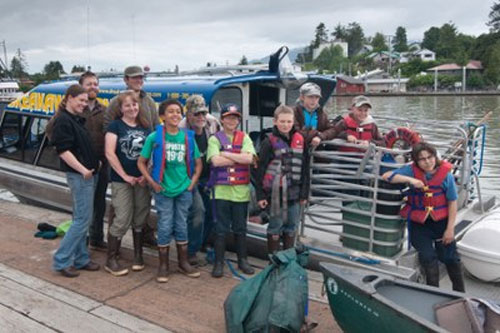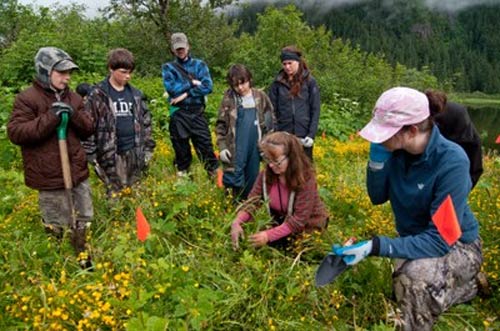
Stikine River Stewardship with the Boy Scouts
June 29, 2012
Members of Wrangell’s Boy Scout Troop 40
The group focused on managing the aggressive reed canary grass along the Twin Lakes shoreline by covering it with sheets of black plastic. Hand pulling and shovels were also used to remove the non-native buttercup and dandelion at the lakes’ landing. Reed canary grass is a tall grass that invades and dominates riparian areas, displacing native plants and reducing the richness and diversity of insects. Non-native buttercup and dandelion are not as aggressive, but can push out native plant species. In total, the group worked a collective 304 hours over the course of five days. "We want to make sure reed canary grass doesn't take up native plants because moose and other animals don't eat reed canary grass," said Boy Scout Tymon Teat.
Members of Wrangell’s Boy Scout Troop 40...
"We need the help, and I thank the Boy Scouts for that, I thank SEACC for stepping up, and I thank Sitka Conservation for their help," said Dave Rak of the US Forest Service. "I've been moose and bear hunting this area since 1980 and never noticed any dandelions or other invasives until just recently,” said Assistant Troop Leader Glenn Smith. “Having my son up here, it's important to show him the things that aren't native." When the Scouts and volunteers were not pulling weeds, they had an opportunity to reaffirm their connection to the land and enjoy what it means to be in the Wilderness. Scouts spent their lunch breaks and evenings swimming, catching insects and amphibians, and watching the sun set from the desert on Andrew's Island. The Twin Lakes trip came just a week after Troop 40's trash clean-up on Zarembo Island, where they collected more than 900 pounds of trash. "More stewardship,” said Assistant Scout Master Kim Powell. “We are willing to help in any way we can."
Source of News:
E-mail your news &
photos to editor@sitnews.us
|
||

